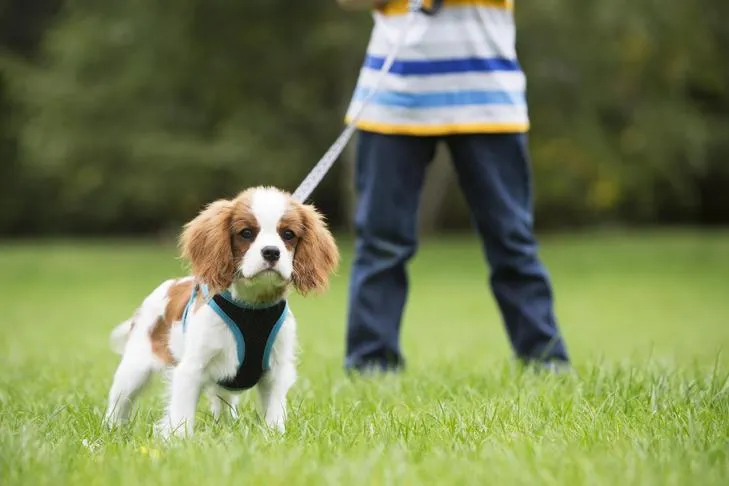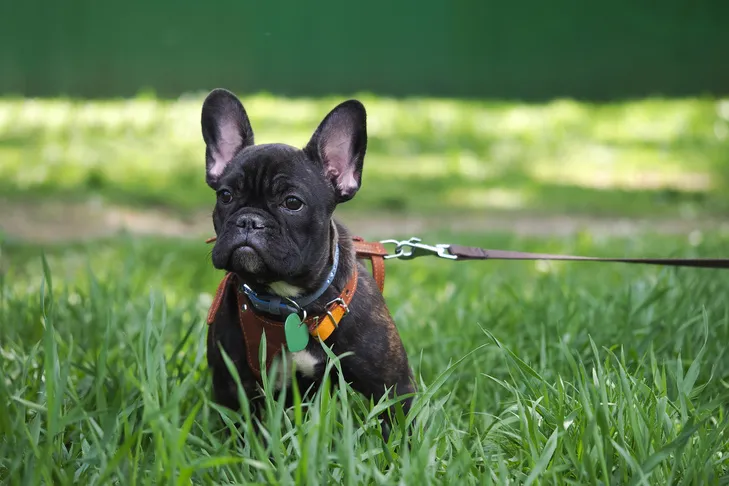Taking your puppy for regular walks is a cornerstone of their physical and mental development. These outings are crucial for providing essential exercise and vital socialization opportunities, shaping them into well-adjusted canine companions. However, puppies aren’t born with an innate understanding of leash walking. Some may naturally trot alongside you, while others might strain ahead, but a significant number of puppies react to the leash as if it were a command to freeze, refusing to take a single step. This reluctance can be perplexing for new owners. Why does the simple act of clipping on a leash turn your eager puppy into a statue? The underlying reason often stems from fear – fear of the collar, the leash, or the vast unknown of the outdoors. This guide will delve into the reasons behind your puppy’s hesitant behavior and provide actionable strategies to help them embrace the joy of walks.
While we focus on building confidence for walks, understanding other common puppy behaviors is also important. If your puppy tends to jump up when excited or meeting new people, learning how to stop your dog jumping up people or how to stop your dog jumping up at guests can complement your efforts.
Building a Positive Association with the Leash
For many puppies, the mere act of attaching a leash can be enough to trigger an immediate shutdown. A leash, by its very nature, is a form of restraint. It limits their ability to move freely or to escape from situations that they perceive as frightening. This feeling of being confined can be deeply intimidating. Instead of viewing the leash as an invitation to an exciting adventure, they associate it with fear and restriction.
The discomfort can even begin with the collar itself. A new collar can feel strange and intrusive. If a puppy has had negative experiences where the collar was used to forcibly pull or manipulate them, they will likely associate it with unpleasant consequences. The goal is to cultivate a positive relationship, ensuring your puppy feels comfortable wearing their collar and is happy to be gently guided by it.
 Boy walking a King Charles Cavalier Spaniel in a field.
Boy walking a King Charles Cavalier Spaniel in a field.
Ideally, your puppy’s breeder will have already introduced them to wearing a collar and leash. If not, it falls upon you to build their confidence. Begin the process indoors with short, supervised sessions. Engage your puppy in play and offer abundant praise while they are wearing the equipment. Crucially, use high-value treats as rewards. A fun game to play is the “Gotcha” game: gently grasp their collar and immediately follow up with a delicious treat. Through consistent positive reinforcement, your puppy will soon associate their collar and leash with wonderful experiences and positive outcomes.
Once they are comfortable with the collar and leash indoors, you can begin teaching them to walk on it. Still within the safety of your home, use treats to lure your puppy towards you while they are leashed. Offer praise and reward them whenever they move towards you. Gradually, start walking around the house with them. If they show hesitation, use treats to encourage them to follow. Once your puppy is willingly walking with you indoors, transition to the backyard before venturing onto the sidewalk. Keep these training sessions brief, interspersed with frequent praise and rewards, to maintain their enthusiasm.
Gently Introducing Your Puppy to the Outdoors
When you begin taking your training efforts outside, it’s essential to remember that the external environment can be a sensory overload for many puppies. The multitude of sights, sounds, and smells can be overwhelming. Effective socialization is key to overcoming your puppy’s anxiety and fostering a sense of confidence.
Expose your puppy to a diverse range of people, varying in appearance and demeanor. Don’t overlook differences such as people wearing glasses, using wheelchairs, or sporting hats, as these can be novel to a young dog. It’s also crucial to introduce your puppy to various other dogs and different environments. However, avoid forcing any interactions. Allow your puppy to initiate contact and progress at their own pace. Keep all new experiences positive by pairing them with play, praise, and treats. This consistent positive association will help your puppy become comfortable with the world around them, viewing other people and dogs as potential friends rather than sources of threat.
 French bulldog puppy in a harness sitting in tall green grass on a leash for a walk.
French bulldog puppy in a harness sitting in tall green grass on a leash for a walk.
If your puppy struggles with apprehension around new people, learning how to teach my dog not to jump up can be beneficial as you work on broader confidence-building exercises.
Fostering a Love for Walks
Your initial excursions outside should prioritize enjoyment and exploration. Don’t be concerned with perfect leash manners or teaching your puppy to heel at this stage. Instead, encourage them to explore their surroundings and engage with the myriad of new smells. To ensure your dog has the best possible walking experience, avoid rushing them through bathroom breaks or abruptly pulling on the leash. Remember, the leash is a safety tool, not a device for forceful control. Your puppy will never learn to love the leash if it’s consistently used to pull them along.
Initially, it’s common for puppies to drag their heels or pull backward rather than walk forward with you. Don’t get caught up in how to teach your puppy to stop jumping on guests or how to achieve a perfectly loose leash until they are happy and willing to move forward on their own. By maintaining a positive and fun approach, your puppy will soon anticipate walks with excitement. Once this foundation is established, you can then focus on refining their polite walking behavior.
 Beagle puppy on leash walking in the grass.
Beagle puppy on leash walking in the grass.
Practical Tips to Encourage Your Puppy to Walk
If you continue to encounter difficulties in motivating your puppy to walk on leash, consider implementing the following strategies:
- Strategic Relocation: Carry your puppy a short distance, perhaps 20 to 30 feet from your home, and then allow them to walk back independently. This approach allows them to experience the outdoor environment while knowing they are returning to a safe place, which can encourage forward movement.
- Short Car Rides: Drive your puppy a block or two away from home and then let them walk back to the house. This change of scenery can make the walk more engaging.
- Explore New Locations: Drive to a different area, such as a quiet park or a pet-friendly store. Novel environments can spark curiosity and encourage exploration, especially when the familiar sight of home is not immediately visible, potentially reducing their instinct to retreat.
- Enticing Companions: Have a friend or a calm, well-behaved dog stand on the sidewalk a short distance away from your home. This can provide your puppy with an exciting motivator to walk towards.
- High-Value Rewards: Reserve a particularly desirable treat or a favorite toy that your puppy only receives during walks. The anticipation of earning this special reward can be a powerful incentive to walk.
- Enroll in Training Classes: Consider enrolling in a positive reinforcement dog training class. These classes offer an excellent opportunity for socialization and provide hands-on guidance tailored to your puppy’s specific needs. For those struggling with more complex behaviors, learning how to stop my dog from jumping up on visitors can be addressed in a structured class environment.
Regardless of the techniques you employ, maintain an upbeat and positive attitude during your walks. Your puppy is highly attuned to your emotions. If you become anxious or frustrated, it will inevitably impact their perception of the experience. Keep your walks short, enjoyable, and always conclude each outing on a positive note. It may take time, potentially weeks, but every small step you take together will bring you closer to your goal. In due course, your puppy will begin to approach walks with genuine enthusiasm and unwavering confidence.
